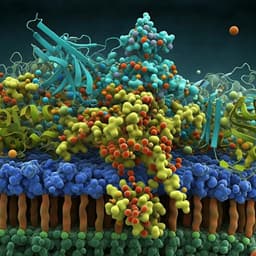
Food Science and Technology
Variation of wine preference amongst consumers is influenced by the composition of salivary proteins
J. Luo, X. Ruan, et al.
This study by Jiaqiang Luo, Xinwei Ruan, Ching-Seng Ang, Yada Nolvachai, Philip J. Marriott, Pangzhen Zhang, and Kate Howell reveals intriguing insights into how differences in saliva proteins can shape wine preferences among different cultural groups, ultimately influencing flavor perception. Discover how the chemical composition of our saliva might affect our tasting experiences.
~3 min • Beginner • English
Introduction
Food preferences vary across individuals and are shaped by multiple factors including culture, age, gender, and diet. Wine is a suitable liquid food model to study cultural influences on flavour preference because its retronasal aroma perception is strongly modulated by saliva once in the oral cavity. Saliva can dilute, bind, or enzymatically transform wine volatiles, thereby altering flavour perception. Prior work suggests that salivary composition (enzymes, proteins, microbiota) varies between populations and could influence aroma release and sensory attributes such as bitterness, astringency, and fruitiness. The research question is whether differences in salivary protein composition between culturally distinct groups (Western vs. Chinese experienced wine tasters) help explain observed differences in wine perception and preference. The study integrates sensory evaluation with chemical and proteomic analyses to test the hypothesis that specific salivary proteins drive group-level differences in wine aroma release and consequent sensory perception.
Literature Review
Previous studies have shown that cultural background and diet shape food preferences and salivary characteristics, including protein content and enzyme activities. Ethnic and dietary differences have been associated with variations in salivary lipolytic and amylolytic activities and AMY1 gene copy number. Studies reported Chinese donors having higher salivary protein concentrations than Caucasian donors, and that diet (e.g., fat intake) correlates with salivary lipase activity. Oral microbiome differences (e.g., Veillonella abundance) have been linked to sensory perceptions like bitterness and astringency. Physiological differences (e.g., obesity) can affect aroma release from wine, potentially via saliva protein content. Individual differences in total salivary protein and antioxidant capacity relate to aroma retention effects. Sensory research indicates cultural differences in the drivers of wine quality (e.g., astringency disliked by Spanish but not necessarily by French consumers). Mechanistically, saliva can dilute volatiles, alter rheology, bind volatiles via proteins (e.g., α-amylase, mucins), and modify volatiles via enzymes such as esterases, aldehyde dehydrogenases, and peroxidases. Tannins interact with salivary proline-rich proteins (PRPs) to form complexes implicated in astringency and potential aroma retention. Despite these insights, whether differences in salivary protein composition across cultural groups explain variation in wine perception and preference had not been directly tested.
Methodology
Participants: 26 experienced wine tasters in Victoria, Australia (13 Western, 13 Chinese), balanced by gender, all with formal wine education or professional experience (e.g., WSET Level 2+). Ethics approval obtained; informed consent given. Demographics included a range of ages and occupations.
Wines: Eight Australian Shiraz wines from different regions and vintages were selected. Basic wine chemistry was measured (pH, alcohol, residual sugar, titratable acidity, volatile acidity, malic acid) using an OenoFoss analyser. Total phenolics were measured by Folin–Ciocalteu (as mg GAE/L) and tannins by condensed tannin and BSA precipitation assays (as catechin equivalents).
Sensory evaluation: Two sessions were conducted in controlled sensory booths (22 ± 2 °C, white lighting). (1) Pivot Profile: A pivot wine (mix of equal volumes of all wines) was served alongside each sample (single presentation per session; randomized). Panelists listed attributes as “more” or “less” than pivot; descriptors were grouped into 21 semantic categories. Frequencies were translated to non-negative values and analyzed by correspondence analysis (CA). (2) Continuous scale assessment: Panelists rated intensities of predefined sensory attributes (e.g., fruity, floral, sweet, body, acidity, bitterness, astringency, etc.) and overall liking on continuous scales; data analyzed by principal component analysis (PCA) and nonparametric tests.
Saliva collection and processing: Stimulated saliva was collected pre-sensory using wax gum (5 min collection), centrifuged (15,000×g, 4 °C, 15 min), aliquoted, and stored at −80 °C. For volatile assays, equal volumes from individuals were pooled within group to generate Western and Chinese pooled saliva samples.
Volatile release assays (GC × GC-MS): Headspace SPME GC × GC-MS assessed wine headspace after spiking with pooled saliva (5 mL wine + 1 mL pooled saliva + internal standard 4-octanol), incubated at 36 °C with shortened equilibrium (12 min) and extraction (5 min) to mimic in-mouth conditions. A PDMS/DVB SPME fibre was used. Separation employed SUPELCOWAX 10 (1D) and VF-17ms (2D) columns with helium carrier; EI-MS acquired m/z 50–300. Identification via NIST17 and retention indices; semi-quantification expressed as µg/L 4-octanol equivalents. Assays in triplicate. Additionally, β-lactoglobulin (BLG, a lipocalin analogue) spiking tests used PBS control and BLG at 100 ng/mL and 100 µg/mL to probe potential LCN-1-like effects on volatile release.
Enzyme activity assays: Due to limited volume, pooled saliva samples were assayed in triplicate for total esterase activity (colorimetric method per literature) and α-amylase activity (commercial kit). Results expressed as units of activity per minute.
Proteomics (TMT-based quantitative LC-MS/MS): Saliva proteins were precipitated, reduced (TCEP), alkylated (iodoacetamide), trypsin-digested, SPE-cleaned, and TMT10-plex labelled (with a pooled internal control channel). NanoLC-Orbitrap Lumos acquisition used DDA with HCD MS/MS. MaxQuant searched against UniProt human (TMT settings; variable mods: deamidation NQ, Met oxidation, N-term acetylation; fixed: Cys carbamidomethylation; trypsin/P; ≤2 missed cleavages; FDR 1% at peptide/protein). Reporter intensities (log2, normalized to pool) were processed in Perseus; two-sided t-test with permutation-based FDR (FDR=0.01, s0=2) generated differential abundance results (volcano plot). Proteins with 100% valid values were retained.
Statistics: Sensory group comparisons by Wilcoxon Signed Rank (non-normal data). Volatile differences by Student’s t-test (pooled saliva spiking) and one-way ANOVA (BLG spiking). Enzyme activities and selected protein concentration comparisons by Student’s t-test. Multivariate analyses (PCA, CA) visualized in XLSTAT (v2022.2.1).
Key Findings
- Sensory perception and preference: Chinese tasters perceived significantly stronger fruity, floral, and/or sweet notes in wines 1, 3, 6, 7, and 8; no significant group differences for wines 2, 4, and 5. While overall liking was similar for most wines, the Chinese group showed higher liking for wine 8, which also had the highest alcohol, residual sugar, and condensed tannin contents. PCA/CA revealed distinct attribute drivers: Western tasters favored floral notes and were less attracted to sweet/woody/smooth; Chinese tasters preferred earthy/umami and lower acidity profiles.
- Volatile release (GC × GC-MS): Spiking wine with pooled Chinese saliva yielded significantly higher headspace concentrations (p < 0.05) of most detected volatiles (25 esters, 12 alcohols, 4 aldehydes, 1 acid, 3 terpenes, 2 ketones identified overall), including many esters, alcohols, aldehydes, octanoic acid, and styrene. Western pooled saliva led to higher release for a minority (e.g., ethyl dodecanoate, hexyl acetate, 2,3-butanediol, 2-ethyl-1-hexanol, limonene). These patterns align with stronger perceived fruitiness/floralness in the Chinese group.
- Enzyme activities vs. concentrations: Total salivary protein concentrations did not differ significantly between groups. Proteomics showed no significant differences in the concentrations of esterase or α-amylase between groups; however, pooled Chinese saliva exhibited significantly higher esterase and α-amylase activities (p < 0.05).
- Proteomics: 121 proteins identified; 35 proteins were significantly higher in Chinese saliva (FDR < 0.01, s0=2), including lipocalin-1 (LCN-1). Western saliva had higher levels of several PRPs: PRH1, PRB2, PRB3. Total of 83 proteins showed no significant differences. These differential proteins are implicated in aroma binding and astringency.
- Correlations with sensory attributes: PRPs (PRH1, PRB2, PRB3) were significantly negatively correlated with perceived intensities of floral and fruity attributes across wines, consistent with PRP–tannin complexes binding esters/terpenes and reducing aroma availability. Expected positive associations between PRPs and astringency were not consistently observed, consistent with prior mixed findings. LCN-1 levels showed multiple positive correlations with perceived fruity and floral intensity (e.g., floral in wines 1, 2, 4, 5, 8; fruity in wines 4, 6, 7, 8); one negative correlation with fruitiness in wine 1 was observed.
- Mechanistic probe: BLG (lipocalin proxy) spiking at 100 ng/mL and 100 µg/mL did not significantly alter headspace volatile composition versus buffer, suggesting LCN-1 may not substantially change bulk headspace volatile concentrations at physiological levels; effects may occur via receptor-level interactions or contextual matrix effects.
Discussion
The study demonstrates that experienced Western and Chinese wine tasters differ in perceived aroma attributes and preferences and that these differences correspond with measurable changes in wine headspace volatiles when saliva is introduced and with differences in salivary protein composition. Higher release of esters and other volatiles with Chinese pooled saliva is consistent with stronger perceived fruitiness and floralness in that group. While the total protein concentration and the concentrations of esterase and α-amylase did not differ significantly between groups, enzymatic activities were higher in the Chinese pooled saliva, indicating functional differences that could contribute to in-mouth transformations. Crucially, non-enzymatic salivary protein composition differed: Western tasters had higher PRPs (PRH1, PRB2, PRB3), which correlated negatively with floral/fruity perception, plausibly due to PRP–tannin complexes creating hydrophobic binding sites that retain small aroma molecules, reducing their retronasal availability. Conversely, LCN-1 was more abundant in Chinese saliva and correlated positively with fruity/floral perception in several wines, suggesting a role in enhancing aroma perception, potentially at the receptor level or via local transport, even if not altering bulk headspace concentrations. Together, these findings support the hypothesis that salivary protein composition mediates cultural differences in wine perception and preference. The work provides a biochemical link between consumer physiology and sensory outcomes, highlighting a path for tailoring products to population groups based on salivary profiles.
Conclusion
By integrating sensory profiling, in-mouth volatile release assays, and quantitative salivary proteomics, this study shows that differences in salivary protein composition—particularly elevated PRPs in Western tasters and elevated LCN-1 in Chinese tasters—are associated with group-level differences in wine aroma perception and preference. Chinese pooled saliva promoted greater release of many key volatiles, aligning with stronger perceived fruitiness/floralness and preference for one wine. PRPs negatively correlated with floral/fruity perception, while LCN-1 often correlated positively. These results establish a biochemical basis for inter-group differences in wine preference and point to salivary proteins as targets for understanding and potentially predicting consumer responses to foods and beverages. Future research should expand panel size and diversity, disentangle dietary versus ethnic effects, examine individual (not pooled) saliva effects on volatile release, probe mechanistic roles of specific proteins (e.g., PRP subtypes and LCN-1) at physiological concentrations, and explore applications for product design tailored to consumer segments.
Limitations
- Sample size was modest (n=26; 13 per group), limiting statistical power and generalizability.
- Volatile release experiments used pooled saliva per group, which masks inter-individual variability and may not reflect individual-level mechanisms.
- BLG was used as a proxy for LCN-1; structural similarity does not guarantee identical functional behavior, and LCN-1’s low physiological concentration complicates direct testing.
- Sensory scaling captured predefined attributes and may not encompass the full perceptual space despite inclusion of a free-description Pivot Profile.
- Potential confounders such as diet, lifestyle, and intra-ethnic variability could influence salivary composition; ethnicity and diet are difficult to fully disentangle.
- For spiking tests, Wine 8 from a different vintage (2019) was used due to availability, which could introduce matrix differences.
- The study identifies associations and plausible mechanisms but does not confirm a direct causal pathway for LCN-1’s action on olfactory perception.
Related Publications
Explore these studies to deepen your understanding of the subject.







